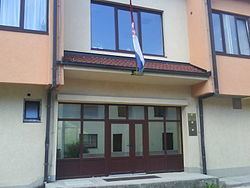Local time Wednesday 1:10 PM | Population 84,127 (2013) | |
 | ||
Weather -1°C, Wind N at 27 km/h, 69% Humidity Points of interest Dinaric Alps, Štrbački buk, Blidinje Lake, Hajji Ahmed the Ducat Mi, Kulen Vakuf | ||
Canton 10 (Croatian: Hercegbosanska županija; Bosnian: Kanton 10; Serbian Cyrillic: Кантон 10) is one of the 10 cantons of the Federation of Bosnia and Herzegovina in Bosnia and Herzegovina. The local government seat is in Livno, while the assembly is in Tomislavgrad.
Contents
- Map of Kanton 10 Bosnia and Herzegovina
- Names symbols and controversy
- Geography
- Topography
- Political subdivisions
- Governance
- Cantonal Assembly
- Demographics
- Economy
- References
Map of Kanton 10, Bosnia and Herzegovina
Names, symbols and controversy
In Croatian the term županija (county) is used, while in Bosnian and Serbian the term is kanton/кантон. The canton is officially referred by the Federation of Bosnia and Herzegovina as Canton 10/County 10 (Kanton 10 or Županija 10). The local government however refers to it as the Herzeg-Bosnian County (Hercegbosanska županija) and uses that name in the local constitution. This name has been deemed unconstitutional by the Federation's Constitutional Court because it contains elements of the name of the country of Bosnia and Herzegovina, which any other canton could contain. Other names used at the national level include North Herzegovina Canton/County (Sjevernohercegovački kanton, Sjevernohercegovačka županija) and Livno Canton (Livanjski kanton), after its capital.
The flag and coat of arms of the canton were the same as the flag and coat of arms of the former Croatian Republic of Herzeg-Bosnia. West Herzegovina Canton was another canton in Bosnia and Herzegovina which also used this flag and coat of arms. However, these symbols were deemed unconstitutional by the Federation Constitutional Court, because "it only represented one group". Defying the court's ruling, the local government continues using these symbols, and the coat of arms is used at plates at the official institutions. Due to the name and symbols dispute, the local police have no official badges.
Geography
The total area of the County is approximately 4,934 square kilometres (1,910 sq mi), a tenth of the surface of Bosnia-Herzegovina and c. 19% of the Federation. The region is located between Dalmatia to the west, Una-Sana Canton to the north, Central Bosnia Canton to the east and West Herzegovina Canton and Herzegovina-Neretva Canton to the south and southeast.
Topography
Mountainous terrain of the region is a part of the Dinaric Alps, linked from a fold and thrust belt dating from the late Jurassic period, itself part of the Alpine orogeny, extending southeast from the southern Alps. The Dinarides form part of a chain of mountains that stretch across southern Europe and isolate Pannonian Basin from the Mediterranean Sea. The highest mountain of the Tropolje Dinarides is Mount Vran, located on the border of the municipalities of Tomislavgrad and Jablanica with the peak called Veliki Vran (Great Vran) at 2,074 metres (6,804 ft).
Political subdivisions
Canton 10 includes 6 municipalities: Drvar, Bosansko Grahovo, Glamoč, Kupres, Livno and Tomislavgrad.
Governance
The canton is governed by the Government of Canton 10 (Croatian: Vlada Hercegbosanske županije; Bosnian: Vlada Kantona 10; Serbian Cyrillic: Влада Кантона 10). The current government is a coalition of 2 parties led by Croatian Democratic Union. President of the government is Branko Ivković.
Cantonal Assembly
The Cantonal Assembly (Croatian: Županijska skupština, Bosnian and Serbian: Kantonalna skupština/Кантонална скупштина) is the parliament of the Canton 10. It consists of 25 representatives elected by proportional representation for four-year terms of office.
Demographics
According to the 1991 census, 115.726 people inhabited the canton. Croats comprised 54.5%, Serbs comprised 32% and Bosnian Muslims comprised 11% of the population. Croats overwhelmingly lived in the southeastern part of the canton (Livno, Kupres, Tomislavgrad), while Serbs lived in northwestern (Grahovo, Glamoč, Drvar). There was a significant population migration during the war (1992-95). In 1992, Serb forces captured Kupres and the surrounding area, pushing away most of the non-Serb population. Croats returned at the end of 1994, after their forces have retaken Kupres. After Croat forces captured Grahovo, Glamoč and Drvar in the summer and fall of 1995, most of the Serb population fled. Refugee Croats from other parts of Bosnia and Herzegovina (fleeing Serb or Bosniak forces) settled in the abandoned area previously inhabited by the Serbs. After the war, under UN and peace implementation forces' pressure, Serb refugees returned to their homes.
In 2013, Canton's population included 76.79% Croats, 12.96% Serbs and 9.55% Bosniaks. Canton 10 had the largest share of ethnic Serbs in the Federation of Bosnia and Herzegovina. However, their number has steadily decreased since the war.
Economy
The canton has significant natural resources, with large reserves of coal and timber, as well as hydro & wind power. Due to economic reasons (insufficient county revenues compared to expenses) unification with West Herzegovina County has been proposed.
